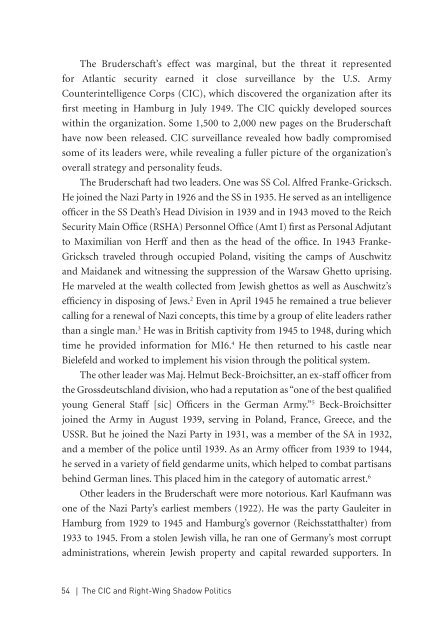erK3dZ
erK3dZ
erK3dZ
Create successful ePaper yourself
Turn your PDF publications into a flip-book with our unique Google optimized e-Paper software.
The Bruderschaft’s effect was marginal, but the threat it representedfor Atlantic security earned it close surveillance by the U.S. ArmyCounterintelligence Corps (CIC), which discovered the organization after itsfirst meeting in Hamburg in July 1949. The CIC quickly developed sourceswithin the organization. Some 1,500 to 2,000 new pages on the Bruderschafthave now been released. CIC surveillance revealed how badly compromisedsome of its leaders were, while revealing a fuller picture of the organization’soverall strategy and personality feuds.The Bruderschaft had two leaders. One was SS Col. Alfred Franke-Gricksch.He joined the Nazi Party in 1926 and the SS in 1935. He served as an intelligenceofficer in the SS Death’s Head Division in 1939 and in 1943 moved to the ReichSecurity Main Office (RSHA) Personnel Office (Amt I) first as Personal Adjutantto Maximilian von Herff and then as the head of the office. In 1943 Franke-Gricksch traveled through occupied Poland, visiting the camps of Auschwitzand Maidanek and witnessing the suppression of the Warsaw Ghetto uprising.He marveled at the wealth collected from Jewish ghettos as well as Auschwitz’sefficiency in disposing of Jews. 2 Even in April 1945 he remained a true believercalling for a renewal of Nazi concepts, this time by a group of elite leaders ratherthan a single man. 3 He was in British captivity from 1945 to 1948, during whichtime he provided information for MI6. 4 He then returned to his castle nearBielefeld and worked to implement his vision through the political system.The other leader was Maj. Helmut Beck-Broichsitter, an ex-staff officer fromthe Grossdeutschland division, who had a reputation as “one of the best qualifiedyoung General Staff [sic] Officers in the German Army.” 5 Beck-Broichsitterjoined the Army in August 1939, serving in Poland, France, Greece, and theUSSR. But he joined the Nazi Party in 1931, was a member of the SA in 1932,and a member of the police until 1939. As an Army officer from 1939 to 1944,he served in a variety of field gendarme units, which helped to combat partisansbehind German lines. This placed him in the category of automatic arrest. 6Other leaders in the Bruderschaft were more notorious. Karl Kaufmann wasone of the Nazi Party’s earliest members (1922). He was the party Gauleiter inHamburg from 1929 to 1945 and Hamburg’s governor (Reichsstatthalter) from1933 to 1945. From a stolen Jewish villa, he ran one of Germany’s most corruptadministrations, wherein Jewish property and capital rewarded supporters. In54 | The CIC and Right-Wing Shadow Politics


